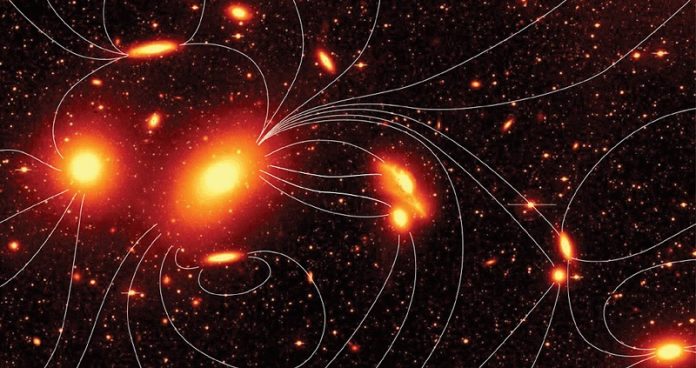
The largest magnetic fields in the universe may have found themselves charged up when the first stars began to shine, according to new research.
Magnetic fields are everywhere in the universe, but most of those magnetic fields arise from a process called a dynamo mechanism.
These are any physical process that can take magnetic fields and stretch them out, twist them up, and fold them over on each other to make them stronger.
For example, dynamo processes in the core of the Earth give us our powerful magnetic field.
But astronomers also find magnetic fields at the very largest of scales, with weak but persistent fields spanning across galaxies or even galaxy clusters.
These fields are usually no stronger than a millionth the strength of the Earth’s, but they can reach for millions of light years in length.
Astronomers have long wondered what powered the creation of these magnetic fields, and a new study has put forward and intriguing hypothesis.
When our Universe was only a few hundred million years old, the first stars began to shine. They quickly died and seeded the universe with bits and pieces of heavier elements, creating the first grains of dust in the process.
When the next generation of stars came online their powerful radiation shown through all the gas and dust surrounding them. That radiation was so powerful that it could literally push on the dust grains.
The dust grains were electrically charged, and once they started moving it created a weak but very large-scale electrical current. An electrical current naturally gives rise to a magnetic field. At first this magnetic field was uniform, but as time went on the dust grains would clump here and there leading to irregularities that would start to mix up entangle the magnetic field.
These magnetic fields were incredibly weak, no more than a billionth the strength of the Earth. But they were very large, the researchers predict, at least a few thousand light-years in size. These are the perfect conditions to allow for dynamo mechanisms to begin to amplify them and stretch them out to their present-day size.
The scenario painted by the researchers is essentially a battery made of dust surrounding newborn stars stretching for thousands of light-years in the early universe. It’s a fascinating possibility, and the researchers propose that the next step is to investigate how the evolution of these fields unfold in detailed simulations of cosmic evolution, and compare those results to observations.
Written by Paul M. Sutte/Universe Today.



